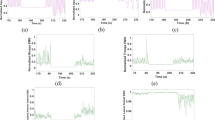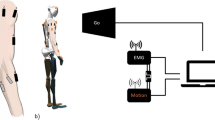Abstract
Artificial neural networks (ANNs) have been used to identify the relationship between electromyographic (EMG) activity and arm kinematics during the execution of motor tasks. Although considerable work has been devoted to showing that ANNs perform this mapping, there has been little work to explore any relationship with physiological properties of the neuromuscular systems. A back-propagation through time (BPTT) ANN was used to map the EMG of five selected muscles (pectoralis major (PM), anterior deltoid (AD), posterior deltoid (PD), biceps brachii (BB) and triceps brachii (TB)) on arm kinematics in seven normal subjects performing three-dimensional unrestrained grasping movements. To investigate the physiological validity of the BPTT-ANN, inputs were artificially altered, and the predicted outputs were analysed. Results show that the BPTT-ANN performed the mapping correctly (root mean square (RMS) error between target and predicted outputs averaged across subject test sets was 0.092±0.015). Moreover, it provided insights into the roles of muscles in performing the movement (average indexes measuring the output alteration with respect to the target were 0.070±0.027, 0.356±0.172, 0.568±0.413, 0.510±0.268, 0.681±0.430 for PM, AD, PD, BB, TB, respectively, in the movement forward phase, and 0.077±0.015, 0.179±0.147, 0.291±0.247, 0.671±0.054, 0.232±0.097 in the return phase).
Similar content being viewed by others
References
Angel, R. W. (1977): ‘Antagonist muscle activity during rapid arm movements: central vs proprioceptive influences’,J. Neurol. Neurosurg. Psychiatry,40, pp. 683–686
Au, A. T. C., andKirsch, R. F. (2000): ‘EMG-based prediction of shoulder and elbow kinematics in able-bodied and spinal cord injured individuals’,IEEE Trans. Rehabil. Eng.,8, pp. 471–480
Campolucci, P., Uncini, A., Piazza, F., andRao, B. D. (1999): ‘On-line learning algorithms for locally recurrent neural networks’,IEEE Trans. Neural Netw.,10, pp. 253–261
Cheron, G., Draye, J. P., Bourgeios, M., andLibert, G. (1996): ‘A dynamic neural network identification of electromiography and arm trajectory relationship during complex movements’,IEEE Trans. Biomed. Eng.,43, pp. 552–558
Dornay, M., Uno, Y., Kawato, M., andSuzuki, R. (1992): ‘Simulation of optimal movements using the minimum-muscle tensionchange model’, inMoody, J. M., Hanson, S. J., andLippman, R. P. (Eds): ‘Advances in neural information processing systems’ (Morgan Kaufmann, San Mateo, 1992), pp. 627–634
Draye, J. P., Pavisic, D. A., Cheron, G. A., andLibert, G. (1996): ‘Dynamic recurrent neural networks: a dynamical analysis’,IEEE Trans. Syst., Man and Cybern. B, Cybern.,26, pp. 692–706
Flash, T., andHogan, N. (1985): ‘The coordination of arm movements: an experimentally confirmed mathematical model’,J. Neurosci.,5, pp. 1688–1703
Gottlieb, G. L., Corcos, D. M., andAgarwal, G. C. (1989): ‘Organizing principles for single-joint movements I. A speed insensitive strategy’,J. Neurophysiol.,62, pp. 342–357
Hagenbuchner, M., andMaggini, M. (1999): ‘The BPTS-software package. A users manual’. Tech. Report, University of Wollongong, Australia and University of Siena, Italy
Hannaford, B., andStark, L. (1985): ‘Roles of elements of the tri-phasic control signal’,Exp. Neurol.,90, pp. 619–634
Happee, R. (1992): ‘Goat directed arm movement. I: analysis of EMG records of shoulder and elbow muscles’J. Electromyogr. Kinesiol.,2, pp. 165–178
Happee, R. (1993): ‘Goal directed arm movement. II: a kinematic model and its relation to EMG records’,J. Electromyogr. Kinesiol.,3, pp. 13–23
Happee, R. (1994): ‘Inverse dynamic optimization including muscular dynamics, a new simulation method applied to goal directed movement’,J. Biomech.,27, pp. 953–960
Hau, W. K. T., Bruce, I. C., Siu, L. Y. L., andChen, E. Y. H. (1998): ‘Motor programs: an artificial neural network approach’, Proc. 20th Annual Int. Conf. of IEEE Engineering in Medicine and Biology Society,20, pp. 1434–1437
Jacobs, R., andTucker, C. A. (2000): ‘Soft computing techniques for evaluation and control of human performance’, inWinters, J. M., andCrago, P. E. (Eds): ‘Biomechanics and neural control of posture and movement’ (Springer-Verlag, New York, 2000), pp. 551–562
Katayama, M., andKawato, M. (1993): ‘Virtual trajectory and stiffness ellipse during multijoint arm movement predicted by neural inverse models’,Biol. Cybern.,69, pp. 353–362
Koike, Y., andKawato, M. (1995): ‘Estimation of dynamic joint torques and trajectory formation from surface electromiography signals using a neural network model’,Biol. Cybern.,73, pp. 291–300
Luh, J. J., Chang, G. C., Cheng, C. K., Lai, J. S., andKuo, E. S. (1999): ‘Isokinetic elbow joint torques estimation from surface EMG and joint kinematic data: using an artificial neural network model’,J. Electromyogr: Kinesiol.,9, pp. 173–183
Morasso, P. (1981): ‘Spatial control of arm movements’,Exp. Brain Res.,42, pp. 223–227
Narendra, K. S., andParthasarathy, K. (1990): ‘Identification and control of dynamical systems using neural networks’,IEEE Trans. Neural Netw.,1, pp. 1–27
Sanes, J. N., andJennings, V. A. (1984): ‘Centrally programmed patterns of muscle activity in voluntary motor behavior in humans’,Exp. Brain Res.,54, pp. 23–32
Stroeve, S. (2000): ‘Commentary: what's the use of black box musculoskeletal models?’, inWinters, J. M., andCrago, P. E. (Eds): ‘Biomechanics and neural control of posture and movement’ (Springer-Verlag, New York, 2000), pp. 456–457
Van Der Helm, F. C. T. (2000): ‘Large-scale musculoskeletal systems: sensorymotor integration and optimisation’, inWinters, J. M., andCrago, P. E. (Eds): ‘Biomechanics and neural control of posture and movement’ (Springer-Verlag, New York, 2000), pp. 407–424
Wadman, W. J., Vand Der Gon, J. J. D., andDerksen, R. J. A. (1980): ‘Muscle activation patterns for fast directed arm movements’,J. Human Move. Stud.,6, pp. 19–37
Werbos, P. J. (1990): ‘Backpropagation through time: what it does and how to do it’,Proc. IEEE,78, pp. 1550–1560
Wolpert, D. M., andKawato, M. (1998): ‘Multiple paired forward and inverse model for motor control’,Neural Netw.,11, pp. 1317–1329
Author information
Authors and Affiliations
Corresponding author
Rights and permissions
About this article
Cite this article
Dipietro, L., Sabatini, A.M. & Dario, P. Artificial neural network model of the mapping between electromyographic activation and trajectory patterns in free-arm movements. Med. Biol. Eng. Comput. 41, 124–132 (2003). https://doi.org/10.1007/BF02344879
Received:
Accepted:
Issue Date:
DOI: https://doi.org/10.1007/BF02344879




